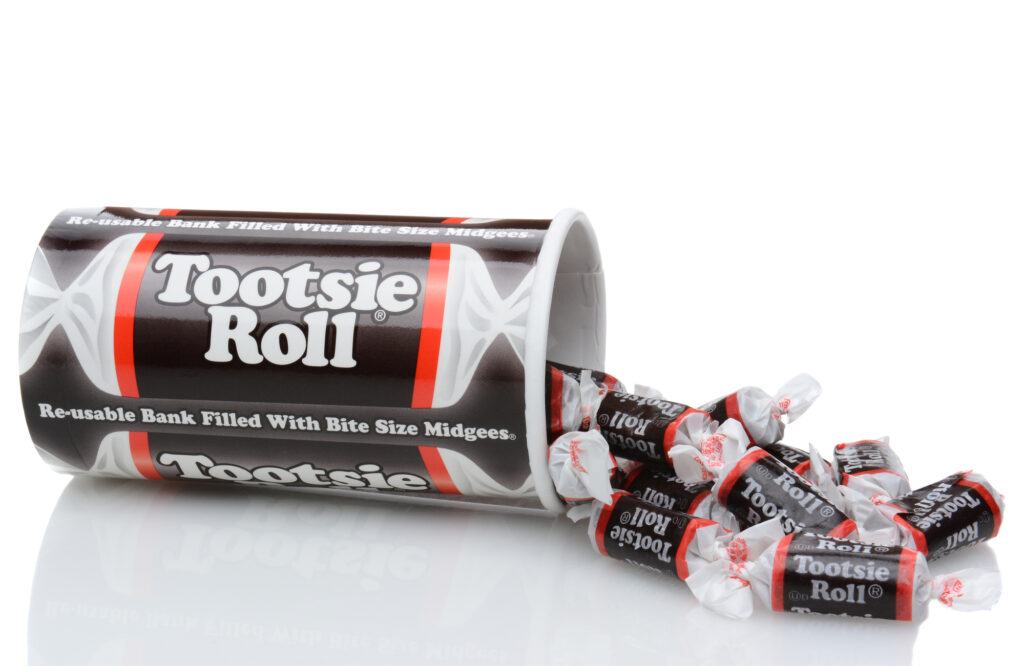The goal is the Tootsie Roll center buried in a hard-shell lollipop. There’s one rule – only licks, not bites.
Tootsie Roll Pops were introduced in 1931. During the Great Depression the popular candy was cheap, colorful, and delicious. It all began when employees at the Sweets Company of America (later known as Tootsie Roll Industries) were asked to pitch ideas for a new candy. Luke Weisgram had a habit of chewing on a Tootsie Roll while licking his daughter’s lollipop.
He put them together.
Today, twenty million Tootsie Roll Pops are produced each day. The classic American candy has flavors like chocolate, cherry, grape, and watermelon. They all hide the coveted Tootsie Roll center . . . and lots of colorful stories.
In 1970, Doner Advertising Agency came up with an iconic TV commercial. Allison Smith wrote in Mashed “it’s arguably one of the longest-running TV commercials ever.”
You know the story.
A cartoon boy asks talking animals a critical question: “how many licks does it take to get to the center of a Tootsie Pop?” Tootsie Roll Industries reported that it got over 20,000 letters from kids trying to answer the riddle.
Budding scientists had to study the question.
Engineering students at Purdue University built a “licking machine” to work like a human tongue. The machine found an average of 364 licks to reach the Tootsie Roll center.
A doctoral student in chemical engineering at the University of Michigan built his own licking machine. The result was 411 licks.
Bellarmine University broke their licking results into gender, color, and flavor. They found it took 175 licks over 14.1 minutes.
Tootsie Roll Industries concluded that “It depends on a variety of factors such as the size of your mouth, the amount of salvia, etc. Basically, the world may never know.”
Cold case. Unsolved mystery.
Let’s head over to the heart of the matter. Tootsie Rolls.
Tootsie Rolls were born over a century ago. In 1896, Austrian-Jewish immigrant, Leo Hirschfield, came up with a simple candy, perhaps from an old family recipe. It was chewy, didn’t melt in the heat, and although not chocolate, had a similar taste. It was also clean – the first individually wrapped penny candy.
Hirschfield called it Tootsie Roll after his daughter Clara’s nickname.
Some food historians believe that Tootsie Rolls were first sold in Hirschfield’s tiny Brooklyn candy store. Others say that Hirschfield was an employee of Stern & Saalberg Confectionary Manufacturers. Either way, Hirschfield patented the candy, merged with Stern & Saalberg, and by 1908, Tootsie Rolls were sold everywhere.
In 1917, Hirschfield became Vice President of the company which had changed its name to Sweets Company of America (later Tootsie Roll Industries). After three years, unhappy with the new generation of owners, either Hirschfield resigned or was fired. No one knows for sure.
 Leo Hirschfield, compliments of Wikimedia Commons
Leo Hirschfield, compliments of Wikimedia Commons
Tootsie Rolls were popular during the Great Depression. During troubled times people tend to reach for sugary comfort foods. Christine Haughney wrote in The New York Times, “When Economy Sours, Tootsie Rolls Soothe Souls.”
Then Tootsie Rolls went to war.
Many compare the chewy, never-spoiling, easily shipped Tootsie Rolls to an early version of energy bars. During World War II they were included in soldiers’ rations, boosting their popularity at home.
A new character emerged in 1943 – Captain Tootsie – complete with comic strips, comic book, and buddies.
In the 1950s Korean War, 60mm mortar ammunition was code-named “tootsie rolls.” According to The First Museum of the American G.I., the American troops faced an overwhelming number of enemies at Chosin Reservoir. The Americans were “strongly outnumbered, outgunned, and undersupplied.” They called for an air drop of “tootsie rolls.”
When the air drop arrived, it was filled with Tootsie Rolls, not the code-named ammo. The soldiers figured out that if they warmed the candy it became like putty. They used it to patch bullet holes in vehicles, hoses, gas tanks, and radiators. It worked. With the repairs they were able to fight the enemy and retreat to safety.
Tootsie Rolls attracted many celebrities. In the 1940s, cowboy Gene Autry promoted the candy. It was Frank Sinatra’s favorite – he insisted that Tootsie Rolls were always in his dressing and hotel rooms. After he passed away, Sinatra was buried with them.
Jacqueline Kennedy Onassis, the former First Lady, demanded that a bowl of Tootsie Rolls always be at her receptionist’s desk.
In the 1990s the hip-hop group, 69 Boyz, released Let Me See That Tootsie Roll. It was a hit, along with the accompanying dance.
In 2009, The Orthodox Union declared Tootsie Rolls kosher. Now you can find them in Jerusalem.
Today 64 million Tootsie Rolls are made each day. They come in different sizes and flavors. There’s a National Tootsie Roll Day and Amazon sells Tootsie Roll dresses, costumes, tee shirts, and toys.
Go for it, tootsie!






